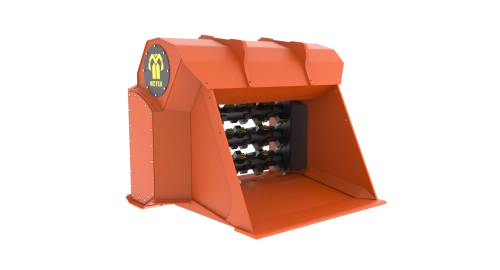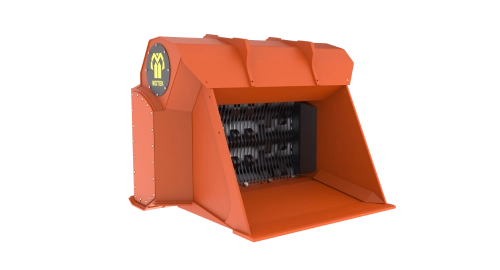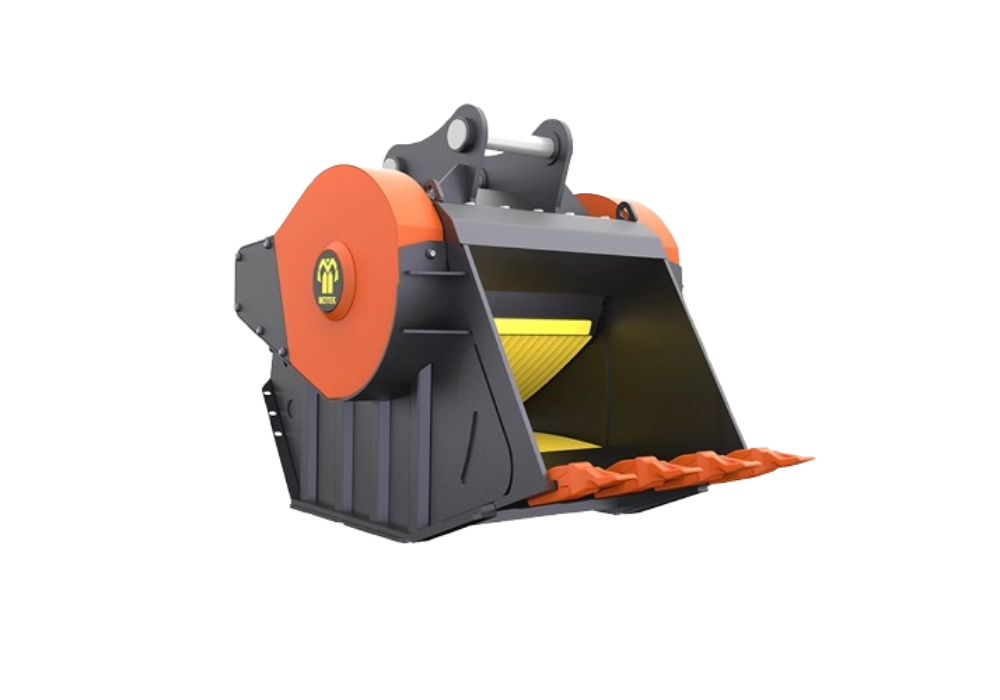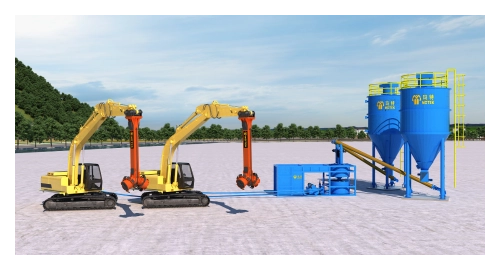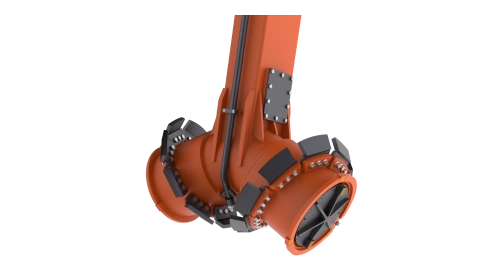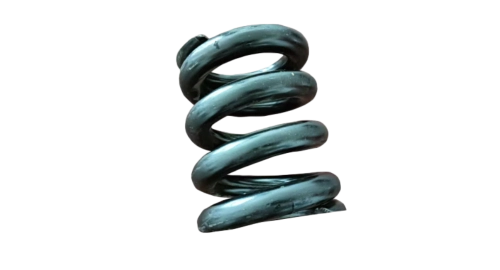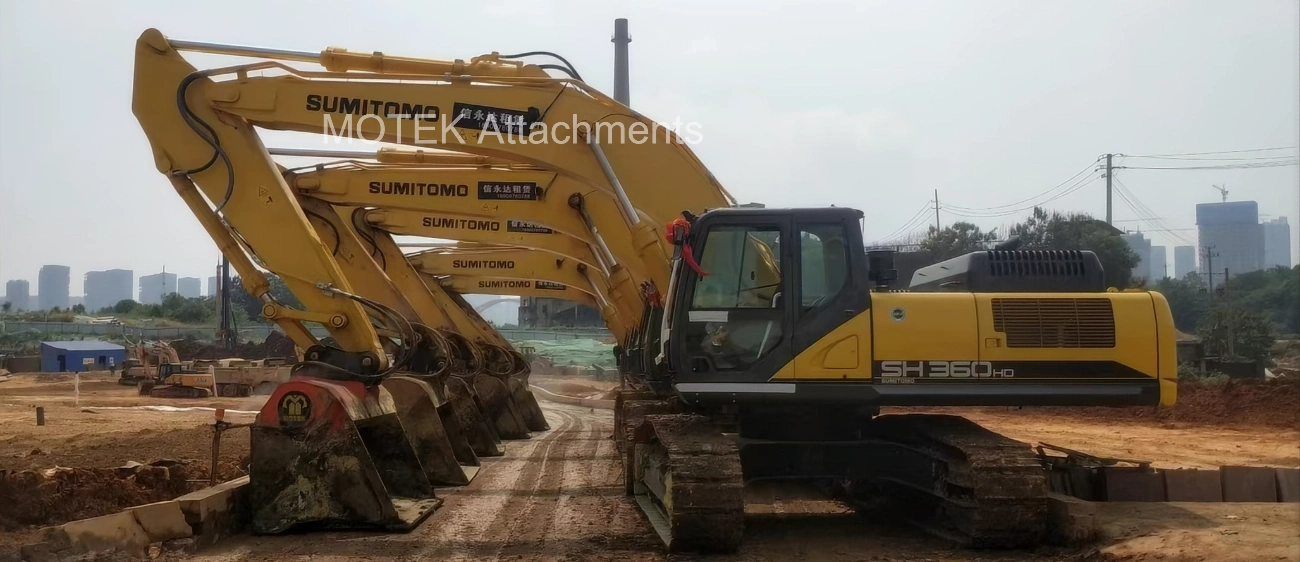MOTEK Screening Bucket: the core pretreatment in soil remediation mixture
Release time: 2025-06-05
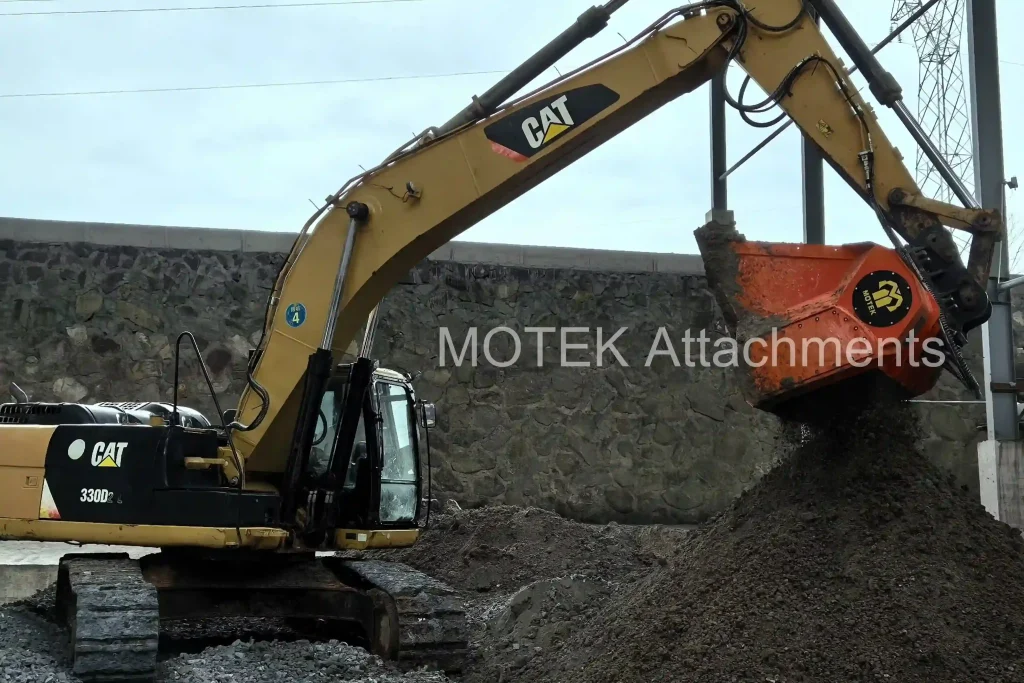
In the complex system engineering of soil remediation, the treatment effect of contaminated soil is highly dependent on the precise addition of remediation agents and their full and uniform contact and reaction with pollutants. The preparation quality of the remediation mixture (usually composed of contaminated soil, solidification/stabilization agents, and regulating materials such as aggregates or water) is one of the core links that determine the success or failure of remediation. In this key process, MOTEK rock screening bucket (also called the crushing screening bucket or processing bucket) is by no means a simple material transfer container, but a multifunctional intelligent pretreatment core equipment, playing the important role of “material finisher” and “first line of defense for quality”. It plays an irreplaceable role in ensuring the uniformity, purity, reactivity and overall remediation efficiency of the mixture.
Core Function Analysis: Multi-dimensional Value of MOTEK Screening Bucket
1. Powerful crushing, releasing pollutants and reagent activity:
Source of the problem: Contaminated soil (especially clay or soil that has been compacted for a long time) and some added powdered reagents (such as lime, cement, and some redox reagents) are very easy to form hard lumps (agglomerates) during transportation and storage. These lumps are like miniature “fortresses” with pollutants or unactivated reagent particles wrapped inside.
Function of MOTEK screening bucket: One of the core functions of MOTEK screening bucket attachment is its built-in powerful crushing mechanism (usually high-speed rotating wear-resistant teeth, hammers or striking plates). When the material enters the bucket, these mechanisms cut, impact, squeeze and grind the material forcefully and continuously.
Key value: Effectively break up lumps and dissociate the material into finer and more uniform particles (usually the target particle size is below 50mm, or even finer). This greatly increases the exposed surface area of the pollutants, releases the activity of the encapsulated agents, and clears the physical obstacles for the subsequent effective contact and reaction between the agents and the pollutants. It is a prerequisite for ensuring that the efficiency of the repair reaction (such as solidification encapsulation, chemical oxidation/reduction, adsorption and fixation) meets the design requirements. Without sufficient crushing, even the most efficient mixing equipment will find it difficult to achieve the ideal mixing and reaction effect.
2. Precise screening to remove impurities to ensure the purity of the matrix:
Source of the problem: The soil in the contaminated site is generally mixed with various impurities, such as large stones, construction waste (concrete blocks, bricks, metal fragments), plastics, plant roots, domestic waste, etc. These impurities are not only irrelevant to the remediation goals, but also bring many negative effects.
Function of MOTEK best screening bucket: MOTEK screening bucket for excavator is equipped with replaceable blade grilles and rollers with different apertures. During or after the crushing process, the material moves in the bucket or is forced through the sieve holes by vibration/rotation.
Key value: Protect downstream equipment: Effectively intercept oversized hard impurities (such as stones, concrete blocks) to prevent them from entering the subsequent mixing host (such as twin-shaft mixers, plowshare mixers), avoid serious wear, impact or even jamming damage to the mixing blades, shafts, liners, etc., and greatly reduce equipment failure rate and maintenance costs.
Ensure the quality of the mixture: Removing impurities ensures the relative purity and consistency of the repair mixture matrix. Impurities will occupy the effective volume and dilute the concentration of the agent; they may hinder the effective contact between the agent and the soil particles; some impurities (such as organic waste and metals) may even react with the repair agent and interfere with the target repair process (such as affecting the strength of the solidified body and changing the redox potential).
Resource recovery/classification and disposal: If the screened stones, construction waste, etc. meet the requirements, they can be considered for resource utilization (such as backfill aggregate), or classified for special disposal to reduce the overall repair cost.
3. Efficient premixing to improve core mixing efficiency:
Source of the problem: Directly putting untreated contaminated soil and powdered/liquid agents into the main mixer often requires a longer mixing time to achieve uniformity, which is inefficient and energy-intensive. The initial state of the materials varies greatly (dryness, wetness, particle size).
Function of MOTEK screening buckets: During the crushing and screening process, the materials are continuously lifted, rolled, thrown and cut. This violent mechanical movement itself is a very effective premixing process.
Key value: Preliminary homogenization: To achieve the initial physical mixing and distribution of contaminated soil and added materials (such as dry powder agents, aggregates), significantly reducing the “agglomeration” or “segregation” phenomenon of materials in the initial state.
Improve the efficiency of the main mixing: When the premixed materials enter the main mixer, their uniformity foundation has been greatly improved. This significantly reduces the workload of the main mixing equipment and shortens the core mixing time required to achieve the target mixing uniformity, thereby greatly improving the production efficiency of the entire mixing system and accelerating the progress of the project.
Promote the dispersion of agents: Powdered agents can contact the surface of soil particles earlier and more widely during the premixing process.
Process coordination and engineering value
MOTEK screening bucket does not work in isolation. It works closely with the entire soil remediation mixing system (such as feeding equipment, reagent addition system, main mixer, and discharge conveying equipment). It is usually located in the key pre-treatment station before the material enters the main mixer:
1. The core node of the process chain: It receives the contaminated soil from the initial excavation or transportation, completes the key pretreatment (crushing, screening, premixing, and moisture adjustment), lays the foundation for the subsequent high-quality core mixing and reaction, and is the core front-end process to ensure the smooth and efficient operation of the entire mixing process.
2. The cornerstone of quality assurance: By removing impurities, breaking lumps, preliminary homogenization, and adjusting moisture, MOTEK dirt screening bucket greatly improves the quality of materials entering the main mixer from the source. This directly determines the uniformity, purity, and reactivity of the final repair mixture, and is the key prerequisite for ensuring that the repair effect meets the standards (pollutant leaching concentration, engineering performance).
3. Efficiency and economic booster:
Shorten construction period: improve the efficiency of main mixing and speed up batch processing.
Reduce energy consumption: reduce the burden on the main mixer and reduce energy consumption per unit processing volume.
Reduce drug consumption: by fully exposing pollutants and evenly dispersing agents, the dosage of agents can be optimized to avoid local overdosage or underdosage.
Reduce maintenance costs: protect expensive core mixing equipment from damage by large impurities.
Resource optimization: reuse the usable aggregates screened out to reduce the cost of external purchase and disposal.
4. Adaptability and flexibility: MOTEK screening buckets are usually designed to be modular, with quick-change blades and drums, and can flexibly adapt to the material handling requirements of different pollution types (heavy metals, organic matter), different soil properties (clay, sandy soil, gravelly soil) and different remediation technologies.
Application scenarios and technical associations
The role of MOTEK screening bucket runs through the material preparation stage of various mainstream soil remediation technologies:
Solidification/stabilization (S/S): The crushing homogeneity is extremely high, and MOTEK screening bucket is the key to ensure that the agent encapsulates the pollutants. Moisture regulation is crucial for hydration reactions.
Chemical oxidation/reduction: The pollutants need to be fully exposed and in uniform contact with the agent. It is very important to remove interfering impurities (such as oxygen-consuming organic matter and metal fragments).
Soil leaching (as a pretreatment): Provide feed with qualified particle size and less impurities for subsequent wet screening, hydraulic sorting or elution.
Bioremediation (composting, biopile): Crushing increases the specific surface area to facilitate microbial colonization, screening removes inhibitors (such as plastics), and adjusts the uniformity of water and nutrients (nutrient solution can be added by spraying).
Thermal desorption/gas phase extraction (pretreatment): Crushing increases the mass transfer efficiency of pollutants volatilizing to the gas phase, and screening removes large impurities that block the air flow channel.
In the field of soil remediation, MOTEK screening bucket has leapt from auxiliary equipment to an indispensable core pretreatment equipment in the mixing mixture preparation process chain. Through the integrated crushing, screening, premixing and moisture adjustment functions, it effectively solves key problems such as agglomeration, impurity interference, initial unevenness, and moisture incompatibility before the material enters the core reaction process. Its role is to fundamentally liberate the reaction activity, ensure the purity of the matrix, lay a uniform foundation, and optimize the reaction environment, thereby significantly improving the quality, reaction efficiency and engineering reliability of the final repair mixture.

